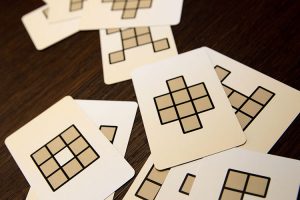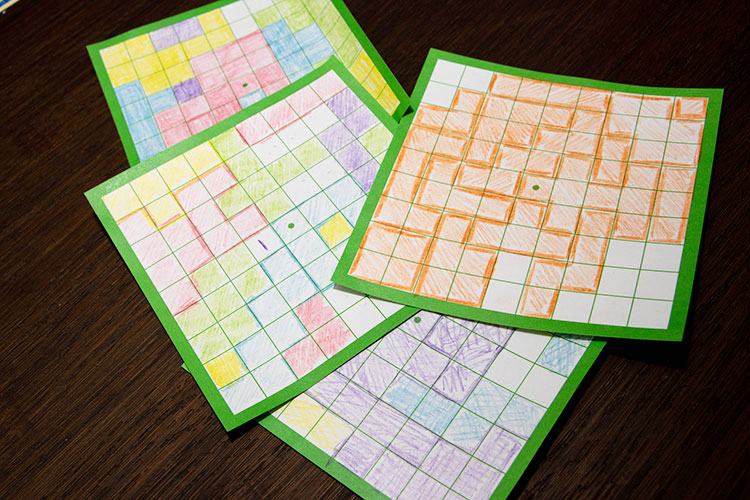 Is flip-and-write the new roll-and-write? Definitely. Is complexity king in what used to be a genre of quick to teach filler games? Without a doubt. Has everything started including polyominoes to the extent that every board gamer now knows that “polyomino” means? Uh huh. But Second Chance is giving—well, a second chance—to games that eschew depth of strategy and replay value in exchange for a game you can play with anyone age 4 to 400 with about 3 minutes of rules and 15 minutes of gamplay. Don’t worry…polyominoes are here to stay.
Is flip-and-write the new roll-and-write? Definitely. Is complexity king in what used to be a genre of quick to teach filler games? Without a doubt. Has everything started including polyominoes to the extent that every board gamer now knows that “polyomino” means? Uh huh. But Second Chance is giving—well, a second chance—to games that eschew depth of strategy and replay value in exchange for a game you can play with anyone age 4 to 400 with about 3 minutes of rules and 15 minutes of gamplay. Don’t worry…polyominoes are here to stay.
The question, of course, is if that is enough fun that anyone will want to play it. So let’s take a look at what Second Chance has to offer.
Gameplay Overview:
Second Chance starts with everyone receiving a sheet with an empty 9-by-9 grid and a randomly drawn starting shape. Everyone must draw their unique starting shape on their grid in any orientation they like, but it must cover the center square in some way.

Once everyone has decided on how to place their starting shape the game begins in earnest. Each round two cards will be revealed from the deck. Each card has a polyomino shape on it. Players choose one of the shapes and fill in the appropriate boxes on their page.
It should be noted these aren’t your standard, garden-variety polyominoes. While your Tetris-favorites like the 2×2 block and the T and L shapes exist in the deck, there are also cards that represent a single block and plenty that are odd shapes of 6 or 7 squares.
Your goal is simple—fill in as much of the page as you can. Players may flip and mirror the shape in any way you see fit. It isn’t necessary to connect it in any way to previously drawn shapes.
If you can’t draw either shape, all hope it not lost. Once everyone else has finished, anyone who could not add to their sheet gets (you’ll never guess…) a Second Chance. They are given their own card from the top of the deck; they reveal it and hopefully can add it to their grid. If it fits, they remain in the game and proceed as normal. If they cannot, sorry, no third chances here. They are knocked out of the game and the remaining players proceed.
Once everyone is eliminated, whoever has the fewest empty squares is the winner. The game can, in theory, end if someone completes their entire 9×9 grid successfully.

Game Experience:
I really love what Second Chance offers up here. In many ways, it reminds of Qwinto, which was fairly recently the top game on my Top 10 Roll and Write list. Super quick to learn. Seems almost too simple. And then you quickly realize there is actually stuff going on here.

Now, it’s important to note that my love for Second Chance is partially reliant on two somewhat unexpected components. First, there are cards to place in the middle of the table that shows which shapes exist in the deck of cards. It’s vital to know, for instance, that there are three cards that will allow you to fill in a single square. And just a single 4×1 “line” shape. Keeping an eye on what is drawn, and which shapes are going to be available is key to doing well.
Of course, you can’t always count on those shapes being available to you. Obviously, the deck is randomized and a shape you really need may be on the bottom. Even worse, you might be waiting on the final 1-square card only for someone to draw it as their “second chance” card. This gives just about the perfect amount of randomness to go with otherwise perfect information.
The other component, silly as it may be, is the colored pencils included in the box. In my plays of Second Chance, we’ve made a point to change colors each round. Some of the more artistic among us (read: not me) really go all out adding patterns to each shape. The end result is maybe not high art, but it’s still fun to compare whose paper looks the best once the game part of the game is over.

Final Thoughts:
Second Chance isn’t the type of game that is going to revolutionize the gaming world. There’s a fair criticism that from play to play, the decisions and experience are basically the same. But there is definitely more strategy than you may think in Second Chance.
And of course, it’s perfectly fine just to have a great time coloring in squares, adding patterns, and seeing who can win the sub-game of making the best artwork. It’s a fun filler that is equally relaxing, competitive, and manages to have a few tense moments with the second chance mechanism.
Final Score: 3.5 Stars — An easy to learn spatial puzzle that will also appeal to anyone who loves to color.
 Hits:
Hits:
• Easy to learn at any age.
• Included cards show available shapes giving competitive players information to care about.
• Players who want to focus on pretty patterns can win the unofficial best artwork award.
Misses:
• Feels mostly the same from game to game, likely not a game you will play 50 times.























